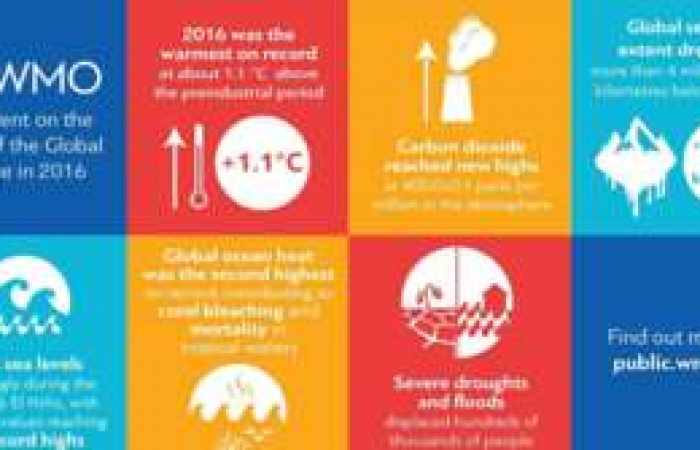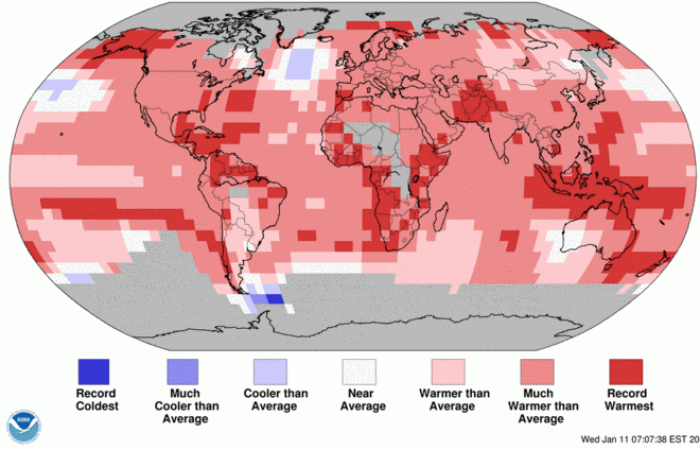It says that 2016 was not only the warmest year on record, but it saw atmospheric CO2 rise to a new high, while Arctic sea ice recorded a new winter low.
The "extreme and unusual" conditions have continued in 2017, it says.
Complete picture
Reports earlier this year from major scientific bodies - including the UK's Met Office, Nasa and NOAA - indicated that 2016 was the warmest year on record.

Some of the key points from the WMO report on the state of the global climate in 2016
The WMO's State of the Global Climate 2016 report builds on this research with information from 80 national weather services to provide a deeper and more complete picture of the year's climate data.
Compared with the 1961-1990 reference period, 2016 was 0.83 degrees C warmer than the average. It was around 1.1C above the pre-industrial period, and at 0.06C just a fraction warmer than the previous warmest year record in 2015.
"This increase in global temperature is consistent with other changes occurring in the climate system," said WMO Secretary-General, Petteri Taalas.
"Globally averaged sea-surface temperatures were also the warmest on record, global sea-levels continued to rise, and Arctic sea-ice extent was well below average for most of the year," he said.
Not all the world warmed at equal speed in 2016.
In the Arctic, temperatures were about 3 degrees C above the 1961-1990 average. In Svalbard, the Norwegian island high in the Arctic circle, the yearly average was 6.5 degrees above the long-term mark.
The report says that temperatures in 2016 were "substantially influenced" by the El Niño weather phenomenon, contributing 0.1 to 0.2 degrees on top of the longer-term warming driven by emissions of CO2.
However, El Niño also had an influence on the levels of the gas in the atmosphere.
"The CO2 rise in 2016 was the fastest on record - 3.4ppm (parts per million) per year - because the El Niño weakened the tropical carbon sink and gave the ongoing CO2 rise an extra kick on top of the effect of human emissions," said Prof Richard Betts from the Met Office Hadley Centre.
"As a result, 2016 became the first year in which CO2 measurements at Mauna Loa remained above 400ppm all year round."
The report states that extreme weather events in 2016 included severe droughts in southern and eastern Africa, and in Central America. Hurricane Matthew in the North Atlantic was one of the most damaging weather-related disasters, leaving hundreds of dead and swathes of destruction across Haiti.
Extremes continue
The WMO says that the "extreme and unusual" climate and weather trends have continued into 2017. At least three times this winter, the Arctic experienced the equivalent of a heatwave, as powerful Atlantic storms drove warm, moist air into the region.
Changes in the Arctic and the melting of sea-ice are also leading to a shift in atmospheric circulation patterns impacting other parts of the world. This is causing unusual heat in some areas - In the US, over 11,000 warm temperature records were broken in early 2017.
"Even without a strong El Niño in 2017, we are seeing other remarkable changes across the planet that are challenging the limits of our understanding of the climate system. We are now in truly uncharted territory," said David Carlson, World Climate Research Programme Director at the WMO.
In the face of all this information, climate researchers around the world are irked by the attitude of the Trump government in Washington.
The new administration has rolled back some of the global warming measures taken by President Obama, while the newly appointed head of the Environmental Protection Agency, Scott Pruitt, denied that CO2 was a primary contributor to warming.
"The WMO's statement on the 2016 climate leaves no room for doubt. The much-hyped warming hiatus is over - and the 'missing' heat energy didn't go missing at all. Instead, that heat went into the ocean, and we got much of it back again last year," said Dr Phil Williamson, from the University of East Anglia.
"Human-driven climate change is now an empirically verifiable fact, combining year-to-year variability with the consequences of our release of extra greenhouse gases. Those who dispute that link are not sceptics, but anti-science deniers."
More about: #science
















































